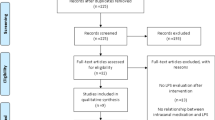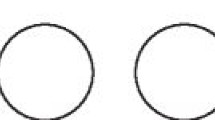Abstract
Background The objective of this overview was to synthesise the current evidence on the role of endotoxins in endodontics infections and to evaluate the effectiveness of endodontic procedures in its removal using information from published systematic reviews.
Methods Electronic databases Medline, Scopus, Embase, Cochrane Library and Google Scholar were searched for reviews published up to July 2021. Systematic reviews on endotoxins based on clinical and/or observational studies were included. The quality of systematic reviews was assessed with the AMSTAR2 tool.
Results A total of five systematic reviews were selected, of which two reviews were of high quality. A significantly higher level of endotoxins were found in teeth with exudation, teeth with a previous episode of pain and pain on percussion. Chemomechanical preparation of root canals significantly reduce endotoxin levels. Calcium hydroxide intracanal medication in symptomatic teeth was significantly effective in endotoxin reduction (standardised mean difference -1.051 [95% confidence interval -2.039 to -0.063]; p <0.05; I2 = 83.3%; certainty of evidence = very low). Multiple session root canal treatment in teeth with symptomatic apical periodontitis was significantly more effective in endotoxins/lipopolysaccharides removal than single-session treatment.
Conclusion Limited quality of evidence showed a significant association of endotoxins in infected teeth with clinical symptoms. Conventional chemomechanical preparation of root canals and intracanal medication were unable to eliminate endotoxins from the root canal system. Future evolution of effective disinfection therapies is warranted.
This is a preview of subscription content, access via your institution
Access options
Subscribe to this journal
Receive 4 print issues and online access
$259.00 per year
only $64.75 per issue
Buy this article
- Purchase on Springer Link
- Instant access to full article PDF
Prices may be subject to local taxes which are calculated during checkout



Similar content being viewed by others
References
Siqueira J F Jr, Rôças I N. Clinical implications and microbiology of bacterial persistence after treatment procedures. J Endod 2008; 34: 1291-1301.
Siqueira J F Jr, Rôças I N. Bacterial pathogenesis and mediators in apical periodontitis. Braz Dent J 2007; 18: 267-280.
Abou-Rass M, Bogen G. Microorganisms in closed periapical lesions. Int Endod J 1998; 31: 39-47.
Martinho F C, Chiesa W M M, Zaia A A et al. Comparison of endotoxin levels in previous studies on primary endodontic infections. J Endod 2011; 37: 163-167.
Barthel C R, Levin L G, Reisner H M, Trope M. TNF-alpha release in monocytes after exposure to calcium hydroxide treated Escherichia coli LPS. Int Endod J 1997; 30: 155-159.
Matsushita K, Tajima T, Tomita K, Takada H, Nagaoka S, Torii M. Inflammatory cytokine production and specific antibody responses to lipopolysaccharide from endodontopathic black-pigmented bacteria in patients with multilesional periapical periodontitis. J Endod 1999; 25: 795-799.
Jacinto R C, Gomes B P, Shah H N, Ferraz C C, Zaia A A, Souza-Filho F J. Quantification of endotoxins in necrotic root canals from symptomatic and asymptomatic teeth. J Med Microbiol 2005; 54: 777-783.
Bronzato J D, Davidian M E S, de Castro M et al. Bacteria and virulence factors in periapical lesions associated with teeth following primary and secondary root canal treatment. Int Endod J 2021; 54: 660-671.
Lipscomb I P, Sihota A K, Keevil C W. Comparative study of surgical instruments from sterile-service departments for presence of residual gram-negative endotoxin and proteinaceous deposits. J Clin Microbiol 2006; 44: 3728-3733.
Wilson M, Reddi K, Henderson B. Cytokine-inducing components of periodontopathogenic bacteria. J Periodontal Res 1996; 31: 393-407.
Sjogren U, Figdor D, Persson S, Sundqvist G. Influence of infection at the time of root filling on the outcome of endodontic treatment of teeth with apical periodontitis. Int Endod J 1997; 30: 297-306.
Fabricius L, Dahlén G, Sundqvist G, Happonen R-P, Möller A J R. Influence of residual bacteria on periapical tissue healing after chemomechanical treatment and root filling of experimentally infected monkey teeth. Eur J Oral Sci 2006; 114: 278-285.
Adl A, Motamedifar M, Shams M S, Mirzaie A. Clinical investigation of the effect of calcium hydroxide intracanal dressing on bacterial lipopolysaccharide reduction from infected root canals. Aust Endod J 2015; 41: 12-16.
Martinho F C, Gomes C C, Nascimento G G, Gomes A P M, Leite F R M. Clinical comparison of the effectiveness of 7- and 14-day intracanal medications in root canal disinfection and inflammatory cytokines. Clin Oral Investig 2018; 22: 523-530.
Silva V, Grande A J, Carvalho A P, Martimbianco A L, Riera R. Overview of systematic reviews - a new type of study. Part II. Sao Paulo Med J 2015; 133: 206-217.
Page M J, McKenzie J E, Bossuyt P M et al. The PRISMA 2020 statement: an updated guideline for reporting systematic reviews. BMJ 2021; DOI: 10.1136/bmj.n71.
Shea B J, Reeves B C, Wells G et al. AMSTAR 2: a critical appraisal tool for systematic reviews that include randomised or non-randomised studies of healthcare interventions, or both. BMJ 2017; DOI: 10.1136/bmj.j4008.
Guyatt G H, Oxman A D, Vist G E et al. GRADE: an emerging consensus on rating quality of evidence and strength of recommendations. BMJ 2008; 336: 924-926.
Gonçalves L S, Rodrigues R C V, Andrade Junior C V, Soares R G, Vettore M V. The Effect of Sodium Hypochlorite and Chlorhexidine as Irrigant Solutions for Root Canal Disinfection: A Systematic Review of Clinical Trials. J Endod 2016; 42: 527-532.
Martins J N R, Saura M, Pagona A. One appointment endodontic procedure on teeth with apical periodontitis: Is this a criterion for success? - A literature review. Rev Port Estomatol Med Dent Cir Maxilofac 2011; 52: 181-186.
Mohammadi Z. Endotoxin in endodontic infections: a review. J Calif Dent Assoc 2011; 39: 152-161.
Sadaf D, Ahmad M Z. Calcium Hydroxide (Ca[Oh]2) as an Intracanal Medication May Significantly Reduce Endotoxins Level from Infected Teeth. J Evid Based Dent Pract 2021; 21: 101616.
Safavi K E, Nichols F C. Effect of calcium hydroxide on bacterial lipopolysaccharide. J Endod 1993; 19: 76-78.
Safavi K E, Nichols F C. Alteration of biological properties of bacterial lipopolysaccharide by calcium hydroxide treatment. J Endod 1994; 20: 127-129.
Nasrabadi N, Jamali S, Vojoodi M G, Jamali M. The Impact of Distinctive Root Canal Instrumentation Systems on Endotoxin Lessening from the Root Canal: A Systematic Review and Meta-Analysis. Pesqu Bras Odontopaediatria Clín Integ 2020; DOI:10.1590/pboci.2021.001.
Bedran N R, Nadelman P, Magno M B et al. Does Calcium Hydroxide Reduce Endotoxins in Infected Root Canals? Systematic Review and Meta-analysis. J Endod 2020; 46: 1545-1558.
Martinho F C, de Rabello D G D, Ferreira L L, Nascimento G G. Participation of endotoxin in root canal infections: A systematic review and meta-analysis. Eur J Dent 2017; 11: 398-406.
Nascimento G G, Rabello D G D, Corazza B J M, Gomes A P M, Silva E G, Martinho F C. Comparison of the effectiveness of single- and multiple-sessions disinfection protocols against endotoxins in root canal infections: systematic review and meta-analysis. Sci Rep 2021; 11: 1226.
Neelakantan P, Ahmed H M A, Chang J W W et al. Effect of instrumentation systems on endotoxin reduction from root canal systems: A systematic review of clinical studies and meta-analysis. Aust Endod J 2019; 45: 407-413.
Neelakantan P, Herrera D R, Pecorari V G A, Gomes B P F A. Endotoxin levels after chemomechanical preparation of root canals with sodium hypochlorite or chlorhexidine: a systematic review of clinical trials and meta-analysis. Int Endod J 2019; 52: 19-27.
Sterne J A, Hernán M A, Reeves B C et al. ROBINS-I: a tool for assessing risk of bias in non-randomised studies of interventions. BMJ 2016; DOI: DOI: 10.1136/bmj.i4919.
Marinho A C, Martinho F C, Zaia A A, Ferraz C C, Gomes B P. Monitoring the effectiveness of root canal procedures on endotoxin levels found in teeth with chronic apical periodontitis. J Appl Oral Sci 2014; 22: 490-495.
Sousa E L, Martinho F C, Nascimento G G, Leite F R, Gomes B P. Quantification of endotoxins in infected root canals and acute apical abscess exudates: monitoring the effectiveness of root canal procedures in the reduction of endotoxins. J Endod 2014; 40: 177-181.
Cardoso F G, Ferreira N S, Martinho F C et al. Correlation between Volume of Apical Periodontitis Determined by Cone-beam Computed Tomography Analysis and Endotoxin Levels Found in Primary Root Canal Infection. J Endod 2015; 41: 1015-1019.
Gomes B, Herrera D R. Etiologic role of root canal infection in apical periodontitis and its relationship with clinical symptomatology. Braz Oral Res 2018; DOI: 10.1590/1807-3107bor-2018.vol32.0069.
Martinho F C, Chiesa W M, Leite F R, Cirelli J A, Gomes B P. Antigenic activity of bacterial endodontic contents from primary root canal infection with periapical lesions against macrophage in the release of interleukin-1beta and tumour necrosis factor alpha. J Endod 2010; 36: 1467-1474.
Garrison S W, Holt S C, Nichols F C. Lipopolysaccharide-stimulated PGE2 release from human monocytes. Comparison of lipopolysaccharides prepared from suspected periodontal pathogens. J Periodontol 1988; 59: 684-687.
Machado F P, Khoury R D, Toia C C et al. Primary versus post-treatment apical periodontitis: microbial composition, lipopolysaccharides and lipoteichoic acid levels, signs and symptoms. Clin Oral Investig 2020; 24: 3169-3179.
Mörmann M, Thederan M, Nackchbandi I, Giese T, Wagner C, Hänsch G M. Lipopolysaccharides (LPS) induce the differentiation of human monocytes to osteoclasts in a tumour necrosis factor (TNF) alpha-dependent manner: a link between infection and pathological bone resorption. Mol Immunol 2008; 45: 3330-3337.
Martinho F C, Leite F R, Nascimento G G, Cirelli J A, Gomes B P. Clinical investigation of bacterial species and endotoxin in endodontic infection and evaluation of root canal content activity against macrophages by cytokine production. Clin Oral Investig 2014; 18: 2095-2102.
Schein B, Schilder H. Endotoxin content in endodontically involved teeth. 1975. J Endod 2006; 32: 293-295.
Silva E J N L, Ferreira V M, Silva C C, Herrera D R, De-Deus G, Gomes B P. Influence of apical enlargement and complementary canal preparation with the Self-Adjusting File on endotoxin reduction in retreatment cases. Int Endod J 2017; 50: 646-651.
Ruksakiet K, Hanak L, Farkas N et al. Antimicrobial Efficacy of Chlorhexidine and Sodium Hypochlorite in Root Canal Disinfection: A Systematic Review and Meta-analysis of Randomized Controlled Trials. J Endod 2020; 46: 1032-1041.
Nelson-Filho P, Leonardo M R, Silva L A, Assed S. Radiographic evaluation of the effect of endotoxin (LPS) plus calcium hydroxide on apical and periapical tissues of dogs. J Endod 2002; 28: 694-696.
Silva L A, Silva R A, Branco L G S, Navarro V P, Nelson-Filho P. Quantitative radiographic evaluation of periapical bone resorption in dog's teeth contaminated with bacterial endotoxin (LPS) associated or not with calcium hydroxide. Braz Dent J 2008; 19: 296-300.
Barbosa-Ribeiro M, Arruda-Vasconcelos R, de-Jesus-Soares A et al. Effectiveness of calcium hydroxide-based intracanal medication on infectious/inflammatory contents in teeth with post-treatment apical periodontitis. Clin Oral Investig 2019; 23: 2759-2766.
Louzada L M, Arruda-Vasconcelos R, Duque T M, Casarin R C V, Feres M, Gomes B. Clinical Investigation of Microbial Profile and Levels of Endotoxins and Lipoteichoic Acid at Different Phases of the Endodontic Treatment in Teeth with Vital Pulp and Associated Periodontal Disease. J Endod 2020; 46: 736-747.
Buck R A, Cai J, Eleazer P D, Staat R H, Hurst H E. Detoxification of endotoxin by endodontic irrigants and calcium hydroxide. J Endod 2001; 27: 325-327.
Jiang J, Zuo J, Chen S-H, Holliday L S. Calcium hydroxide reduces lipopolysaccharide-stimulated osteoclast formation. Oral Surg Oral Med Oral Pathol Oral Radiol Endod 2003; 95: 348-354.
Food and Drug Administration. Guideline on Validation of the Limulus Amebocyte Lysate Test as an End-Product Endotoxin Test for Human and Animal Parenteral Drugs, Biological Products, and Medical Devices. 1987. Available at https://gmpua.com/Validation/Method/LAL/FDAGuidelineForTheValidationA.pdf (accessed October 2022).
Chen L, Mozier N. Comparison of Limulus amebocyte lysate test methods for endotoxin measurement in protein solutions. J Pharm Biomed Anal 2013; 80: 180-185.
Gomes B P, Martinho F C, Vianna M E. Comparison of 2.5% sodium hypochlorite and 2% chlorhexidine gel on oral bacterial lipopolysaccharide reduction from primarily infected root canals. J Endod 2009; 35: 1350-1353.
Author information
Authors and Affiliations
Contributions
Muhammad Z. Ahmad: conceptualisation, data extraction, methodology, writing, reviewing and editing. Durre Sadaf: conceptualisation, methodology, data extraction, software and writing original draft. Khalid A. Merdad: reviewing and validation.
Corresponding author
Ethics declarations
The protocol of this overview was registered in PROSPERO (CRD #42021267175) on 23 July 2021.We did not amend any information in the article provided at registration. The authors declare no conflicts of interest. The review was not funded by any commercial source.
Supplementary Information
Rights and permissions
About this article
Cite this article
Ahmad, M., Merdad, K. & Sadaf, D. An overview of systematic reviews on endotoxins in endodontic infections and the effectiveness of root canal therapy in its removal. Evid Based Dent (2022). https://doi.org/10.1038/s41432-022-0826-x
Received:
Accepted:
Published:
DOI: https://doi.org/10.1038/s41432-022-0826-x



